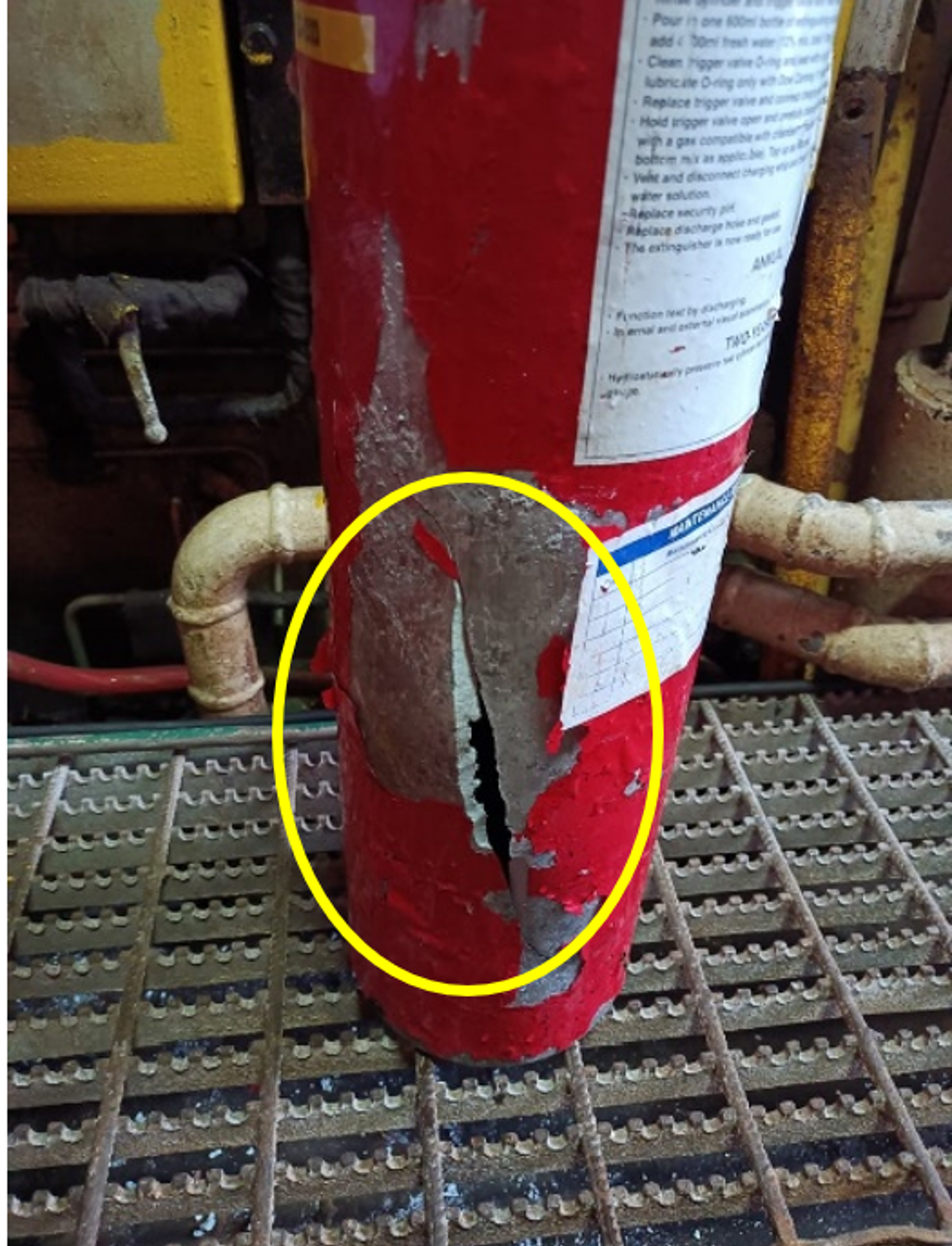Fire extinguisher fails during pressure testing
- Safety Flash
- Published on 30 October 2023
- Generated on 15 December 2025
- IMCA SF 25/23
- 2 minute read
Jump to:
A Member reports a recent incident involving the failure of a 5kg CO2 fire extinguisher during hydrostatic pressure testing.
What happened?
The extinguisher, rated to 200 bar, was being tested to a pressure of 300 bar. The incident occurred when the test pressure reached 196 bar. The extinguisher was 13 years old. No-one was harmed.
What went right?
- The failure occurred under test conditions and no personnel were nearby to get injured.
- The hydrostatic test was a scheduled 5-year test carried out as per the company’s planned maintenance programme.

Ruptured fire extinguisher
What went wrong?
The main body of the extinguisher failed. Our Member noted the following points:
- General Wear and Tear: Over time, fire extinguishers are subjected to various environmental factors and conditions that can lead to wear and tear. This wear and tear may include corrosion, stress, or weakening of materials due to exposure to temperature fluctuations and external elements. It is essential to regularly inspect and maintain fire extinguishers to ensure their integrity.
- Age of the Extinguisher: The extinguisher in question was manufactured in July 2010, making it over a decade old at the time of the incident. As fire extinguishers age, their components, including pressure vessels and seals, can deteriorate. Over time, the ability of the extinguisher to withstand high-pressure testing may diminish, increasing the risk of failure.
Lessons and actions
- The failure serves as a reminder of the importance of regular inspection, maintenance, and age considerations when dealing with critical safety equipment.
- When in doubt about the condition of a fire extinguisher, consult with experts or manufacturers for guidance on inspection, testing, and replacement intervals.
- Our Member took the following actions:
- Reviewed the current inspection and maintenance program to ensure it is implemented correctly and is rigorous enough for inspection and maintenance of fire extinguishers.
- Considered the age of fire extinguishers when planning hydrostatic tests. Older extinguishers may require more frequent testing or replacement to ensure their safety and reliability.
- Ensured detailed records of inspections, maintenance, and hydrostatic testing are kept for all fire extinguishers. These records can provide valuable insights into the condition of your equipment over time.
- Ensured that personnel involved in handling and testing fire extinguishers are adequately trained and aware of the potential risks associated with aged or damaged equipment.
- Reviewed the current inspection and maintenance program to ensure it is implemented correctly and is rigorous enough for inspection and maintenance of fire extinguishers.
Related safety flashes
-
IMCA SF 16/21
9 June 2021
-
-
IMCA SF 08/21
17 March 2021
-
IMCA SF 12/16
6 May 2016
IMCA Safety Flashes summarise key safety matters and incidents, allowing lessons to be more easily learnt for the benefit of the entire offshore industry.
The effectiveness of the IMCA Safety Flash system depends on the industry sharing information and so avoiding repeat incidents. Incidents are classified according to IOGP's Life Saving Rules.
All information is anonymised or sanitised, as appropriate, and warnings for graphic content included where possible.
IMCA makes every effort to ensure both the accuracy and reliability of the information shared, but is not be liable for any guidance and/or recommendation and/or statement herein contained.
The information contained in this document does not fulfil or replace any individual's or Member's legal, regulatory or other duties or obligations in respect of their operations. Individuals and Members remain solely responsible for the safe, lawful and proper conduct of their operations.
Share your safety incidents with IMCA online. Sign-up to receive Safety Flashes straight to your email.